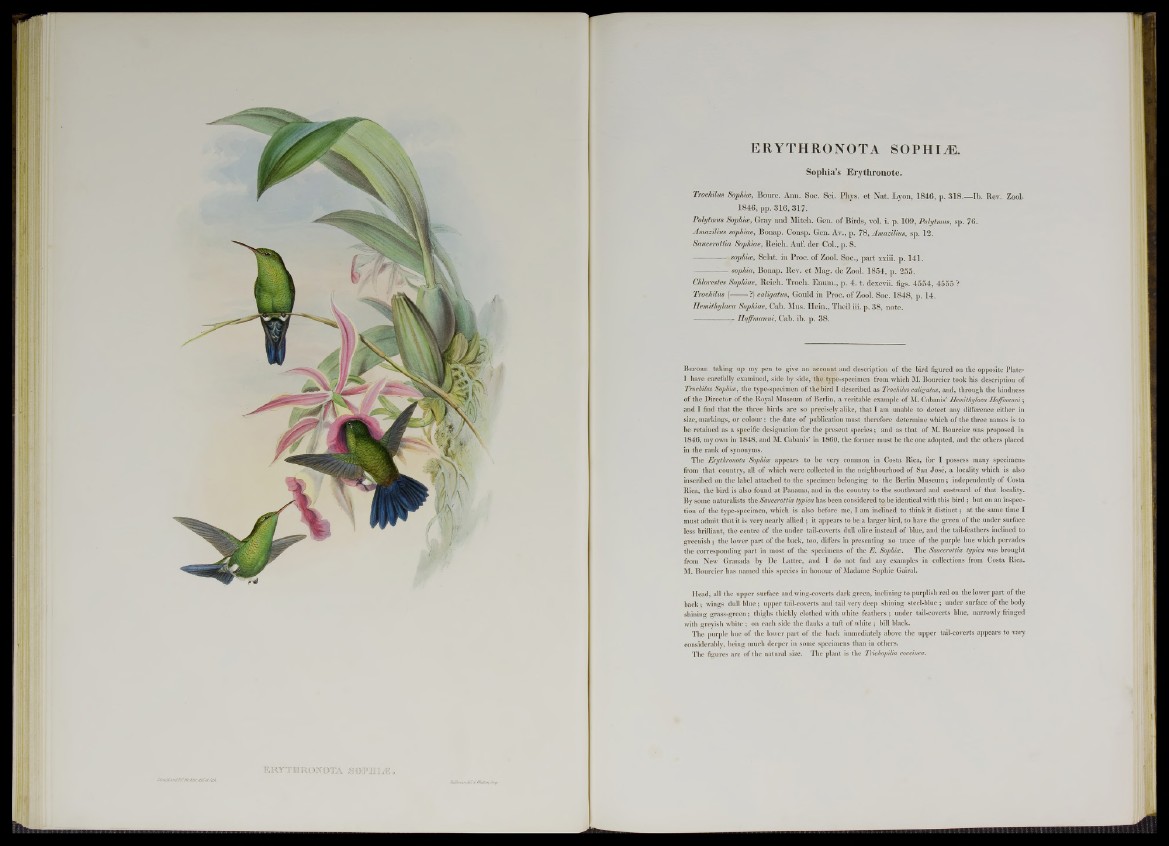
ERYTHRONOTA SOI
JC ouila/tiH C fiitfitv, delict ¿UA
ERYTHRONOTA SOPHIÆ.
Sophia’s Erythronote.
Trochilm Sophia, Bourc. Ann. Soc. Sci. Phys. e t Nat. Lyon, 1846, p. 318.— Ib. Rev. Zool.
1846, pp. 316, 317.
Polytmm Sophia, Gray and Mitch. Gen. o f Birds, vol. i. p. 109, Polytmm, sp. 76.
Amazilim sophiae, Bonap. Consp. Gen. Av., p. 78, Amazilim, sp. 12.
Saucerottia Sophiae, Reich. Auf. der Col., p. 8.
— vsophia, Selat. in Proc. o f Zool. Soc., p a rt xxiii. p. 141.
— sopliia, Bonap. Rev. e t Mag. de Zool. 1854, p . 255.
Chlorestes Sophiae, Reich. Troch. Enum., p. 4. t. dcxcvii. figs. 45 5 4 , 4555 ?
Trochilm (■--------?) caligatm, Gould in Proc. of Zool. Soc. 1848, p. 14.
Hemithylaca Sophiae, Cab. Mus. H ein ., Theil iii. p. 38, note.
------------- Hoffmanni, Cab. ib. p. 38.
B efore taking up my pen to give an account and description of the bird figured on the opposite Plate»
I have carefully examined, side by side, the type-specimen from which M. Bourcier took his description of
Trochilus Sophia, the type-specimen of the bird I described as Trochilus caligatus, and, through the kindness
of the Director of the Royal Museum of Berlin, a veritable example of M. Cabanis’ Hemithylaca Hoffmanni ;
and I find that the three birds are so precisely alike, that I am unable to detect any difference either in
size, markings, or colour : the date of publication must therefore determine which of the three names is to
be retained as a specific designation for the present species ; and as that of M. Bourcier was proposed in
1846, my own in 1848, and M. Cabanis’ in 1860, the former must be the one adopted, and the others placed
in the rank of synonyms.
The Erythronota Sophia appears to be very common in Costa Rica, for I possess many specimens
from that country, all of which were collected in the neighbourhood of San José, a locality which is also
inscribed on the label attached to the specimen belonging to the Berlin Museum ; independently of Costa
Rica, the bird is also found at Panama, and in the country to the southward and eastward of that locality.
By some naturalists the Saucerottia txjpica has been considered to be identical with this bird ; but on an inspection
of the type-specimen, which is also before me, I am inclined to think it distiuct ; at the same time I
must admit that it is very nearly allied ; it appears to be.a larger bird, to have the green of the under surface
less brilliant, the centre of the under tail-coverts dull olive instead of blue, and the tail-feathers inclined to
greeuish ; the lower part of the back, too, differs in presenting no trace of the purple hue which pervades
the corresponding part in most of the specimens of the E . Sophia. The Saucerottia typica was brought
from New Granada by De Lattre, and I do not find any examples in collections from Costa Rica.
M. Bourcier has named this species in honour of Madame Sophie Gairal.
Head, all the upper surface and wing-coverts dark green, inclining to purplish red on the lower part of the
back ; wings dull blue ; upper tail-coverts and tail very deep shining steel-blue ; under surface of the body
shining grass-green ; thighs thickly clothed with white feathers ; under tail-coverts blue, narrowly fringed
with greyish white ; on each side the flanks a tuft of white ; bill black.
The purple hue of the lower part of the back immediately above the upper tail-coverts appears to vary
considerably, being much deeper in some specimens than in others.
The figures are of the natural size. The plant is the Trichopilia coccinea.